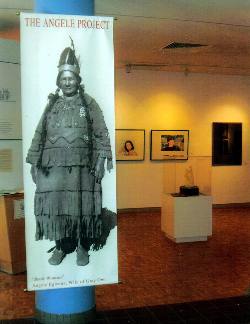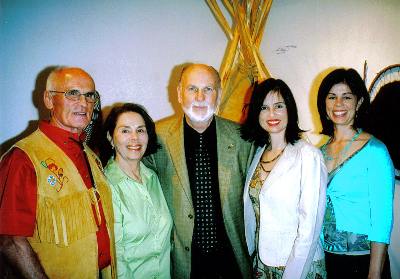 |
June 8, 2007The Angele Project Opens in Temagami
|
The Temagami Community Foundation has brought the Angele
Project to the Train Station in Temagami from June 1 to October 15. The art
exhibition based on the life of Bear Island’s Angele Egwuna (1888-1955) and her
descendants ran in North Bay at the W.K.P. Kennedy Public Art Gallery last
summer. Angele’s life as a Teme-Augama Anishnabi woman living in a period of
transition from an independent native life to one more integrated with a settler
society would be interesting in its own right, but her relationship with the
Englishman Archie Belaney who went on to be the brilliant author, lecturer,
conservationist and native rights advocate Grey Owl adds to her interest.
 |
Angele (Egwuna) Belaney exhibition banner-D. Mackey Photos |
Angele and Archie were 19 years old when Archie arrived in
Temagami 100 years ago this spring and they eventually met and married in 1910
and had a daughter Agnes in 1911. Beside being in love Archie was fascinated
with the native way of life and soon learned the language and the life of a
woodsman. Angele was raised by her uncle John Egwuna after her parents died.
John’s wife was Helen White Bear the sister of Chief White Bear. Archie
constantly took notes and made drawings that he later used in his remarkable
books and lectures.
The restless and neurotic Archie moved on after five years
but came back occasionally including in 1925 when daughter Agnes was a
teenager. It was this same summer that Archie met the future Anahareo and went
on to his remarkable transformation from being a down and out trapper to
national icon.
For a decade after Archie moved on Angele kept Agnes at her
side as she lived as an itinerant bushwoman on the land hunting, fishing, berry
picking and working where she could. Being a single woman she had certain
native privileges including being allowed to trap close to the shore in her
family hunting area and elsewhere on Lake Temagami. She made repairs and
replaced her birchbark canoe herself and made wigwams and lean-tos as required.
Angele and Agnes built a small log house on Fasken Point that was used for
years.
Agnes never went to school but like her mother was very
intelligent and practical. She learned to play by herself usually in bare feet
in summer when she wasn’t helping her mother. When at the family camp at Austin
Bay she was involved in group activity. John Egwuna made her some toys in her
early years and she loved to listen to him playing his violin. In the winter
she learned to skate at Bear Island and was pulled by her mother on a skin
toboggan on their travels until she got older.
Before Agnes was a teenager she stayed at Mom Desrosier’s
restaurant in Temagami while Angele was sick for a period. Agnes eventually
learned English, how to cook, housekeep, house repair, and do crafts that served
her well the rest of her life. As she got older she worked in the store at
Kakina near Bear Island. She saved her money and early on bought a small house
in Temagami.
Agnes eventually married Romeo Lalonde and had four
children which led to many grandchildren. Angele and Agnes were always very
supportive and close to their children. Angele in later life worked a variety
of jobs including craft work. She worked regularly at Camp Acouchiching. Her
husband Willie Turner who she married after Archie Belaney’s death worked at
Camp Chimo and at others jobs on Lake Temagami.
 |
Grey Owl and Angele’s Grandson Albert Lalonde
(left), his wife Jeanette (Laronde) and their daughters Kim and Tracy.
Exhibition Curator Arlie Hoffman, (centre).-D. Mackey Photo
|
A Globe and Mail reporter met Angele at Acouchiching in
1947 while Angele was selling crafts there and found her to be full of life and
good humour. In her story in the paper the reporter noted that “L’Angele
Belaney Turner, stout, brown, toothless, and sparkling of eyes, born outdoors on
a bit of rock and pine is one of the gayest people alive.” Agnes laughed when
she told the reporter that her dress was not deerskin but felt because it would
take too much deerskin to make one. She pointed out that if she shot one deer
the game warden from North Bay would put her in jail – an ironic comment from a
person whose people lived off the land for centuries. Angele talked about how
she went to court in Toronto to get a share of Grey Owl’s estate. Angele died
in 1955 and is buried in Haileybury. Agnes eventually moved to North Bay where
she owned and ran boarding houses and remained close to her family until her
death in 1998 at age 87.
The exhibition has a variety of paintings and artifacts by
Curator Arli Hoffman and painting and sculpture by others including some native
artists all of whom expressed themselves in relation to Angele and Archie and
their descendants. There are a variety of events planned over the summer and
various student groups and others will visit by bus. There will be tour guides
on site and a catalogue on the exhibition plus books and other memorabilia for
sale. Plan on a visit.
For information log on to
www.angeleproject.com or drop by the train station. Congratulations to the
Foundation Planning Committee for their planning, fund raising and mounting of
this memorable exhibition celebrating the life of one of Temagami’s best known
native women and her family.
Heritage Perspective Home Page
| 
![]() Past
Forward is now on Facebook "LIKE" us to keep in touch
Past
Forward is now on Facebook "LIKE" us to keep in touch